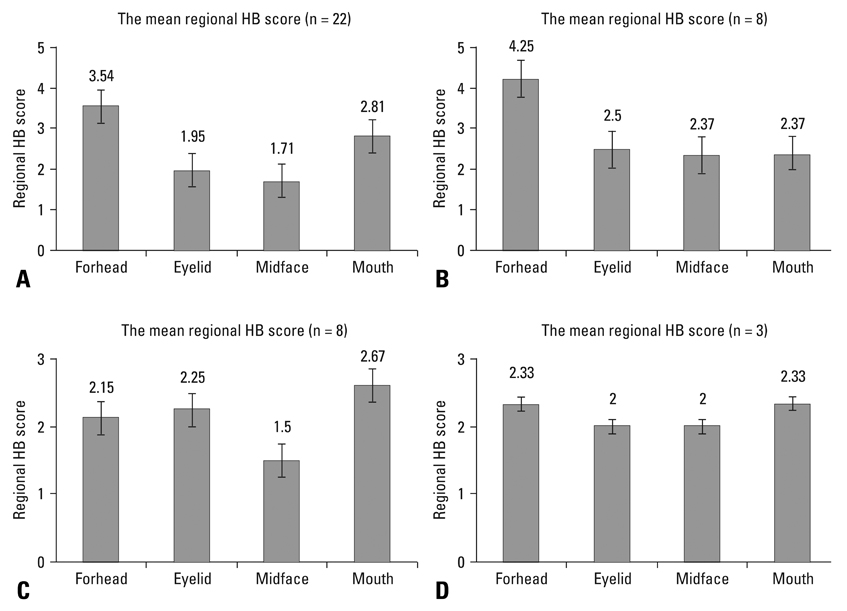Yonsei Med J.
2010 Nov;51(6):943-948. 10.3349/ymj.2010.51.6.943.
Features of Facial Asymmetry Following Incomplete Recovery from Facial Paralysis
- Affiliations
-
- 1Department of Otorhinolaryngology, Yonsei University College of Medicine, Seoul, Korea. wsleemd@yuhs.ac
- KMID: 1779644
- DOI: http://doi.org/10.3349/ymj.2010.51.6.943
Abstract
- PURPOSE
The purpose of this study is to investigate peculiar patterns of facial asymmetry following incomplete recovery from facial paralysis that require optimal physical therapy for effective facial rehabilitation, and to decrease the incidence of avoidable facial sequelae.
MATERIALS AND METHODS
This study involved 41 patients who had facial sequelae following the treatment of various facial nerve diseases from March 2000 to March 2007. All patients with a follow-up of at least 1 year after the onset of facial paralysis or hyperactive function of the facial nerve were evaluated with the global and regional House-Brackmann (HB) grading systems. The mean global HB scores and regional HB scores with standard deviations were calculated. Other factors were also analyzed.
RESULTS
Four patterns of facial asymmetry can be observed in patients with incomplete facial recovery. The most frequently deteriorated facial movement is frontal wrinkling, followed by an open mouth, smile, or lip pucker in patients with sequelae following facial nerve injury. The most common type of synkinesis was unintended eye closure with an effort to smile.
CONCLUSION
We described common configurations of facial asymmetry seen in incomplete recovery following facial nerve injury in an attempt to develop an optimal strategy for physical therapy for complete and effective facial recovery, and to decrease the incidence of avoidable sequelae.
Keyword
MeSH Terms
Figure
Reference
-
1. Lundborg G. Nerve Injury and Repair. 2004. 2nd ed. Edinburgh: Churchill Livingstone.2. Yen TL, Driscoll CL, Lalwani AK. Significance of House-Brackmann facial nerve grading global score in the setting of differential facial nerve function. Otol Neurotol. 2003. 24:118–122.
Article3. Neely JG, Neufeld PS. Defining functional limitation, disability, and societal limitations in patients with facial paresis: initial pilot questionnaire. Am J Otol. 1996. 17:340–342.4. Twerski A, Twerski B. May M, editor. The emotional impact of facial paralysis. The facial nerve. 1986. New York, NY: Thieme;788–794.5. Schmidt KL, VanSwearingen JM, Levenstein RM. Speed, amplitude, and asymmetry of lip movement in voluntary puckering and blowing expressions: implications for facial assessment. Motor Control. 2005. 9:270–280.
Article6. Bateman DE. Facial palsy. Br J Hosp Med. 1992. 47:430–431.7. Ohye RG, Altenberger EA. Bell's palsy. Am Fam Physician. 1989. 40:159–166.8. Brach JS, VanSwearingen JM, Lenert J, Johnson PC. Facial neuromuscular retraining for oral synkinesis. Plast Reconstr Surg. 1997. 99:1922–1931.
Article9. Deleyiannis FW, Askari M, Schmidt KL, Henkelmann TC, VanSwearingen JM, Manders EK. Muscle activity in the partially paralyzed face after placement of a fascial sling: a prelliminary report. Ann Plast Surg. 2005. 55:449–455.
Article10. Manikandan N. Effect of facial neuromuscular re-education on facial symmetry in patients with Bell's palsy: a randomized controlled trial. Clin Rehabil. 2007. 21:338–343.
Article11. VanSwearingen JM, Brach JS. Changes in facial movement and synkinesis with facial neuromuscular reeducation. Plast Reconstr Surg. 2003. 111:2370–2375.
Article12. Spiegel JH, Goerig RC, Lufler RS, Hoagland TM. Frontalis midline dehiscence: an anatomical study and discussion of clinical relevance. J Plast Reconstr Aesthet Surg. 2009. 62:950–954.
Article13. Miehlke A, Fisch Ugo, Eneroth CM. Surgery of the facial nerve. 1973. 2nd ed. Baltimore: Urban & Schwarzenberg.14. Meier JL, Straus SE. Comparative biology of latent varicellazoster virus and herpes simplex virus infections. J Infect Dis. 1992. 166:S13–S23.
- Full Text Links
- Actions
-
Cited
- CITED
-
- Close
- Share
- Similar articles
-
- Botox Therapy for Deep Nasolabial Fold and Bitterness Furrow after Facial Nerve Paralysis
- What Causes Incomplete Facial Function Recovery in Patients with Immediate Facial Paralysis Following Vestibular Schwannoma Surgery?
- Acute Inflammatory Facial Nerve Paralysis
- Post-traumatic Bilateral Facial Paralysis: A Case Report
- Surgical Treatment of Facial Paralysis


